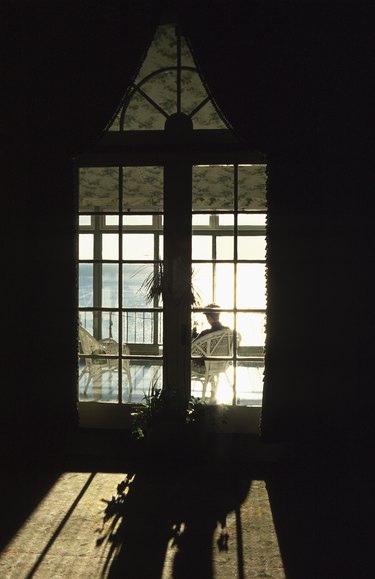
Two doors that meet at the center and are made of rectangular glass panes, which extend the full length of both doors, seem to invite intruders. French doors, so named for their origin in France, were brought to the American South by settlers. They are adaptable in colder areas with thermal glass or the addition of storm doors. Security, however, requires some specialized hardware beyond the average deadbolt lock.
Compromises
Video of the Day
A simple deadbolt, no matter the length, will not secure two movable doors to each other. French doors that open outward have an added problem; their hinge pins are on the outside of the door, inviting an intruder to slip them out and pull one door away from the other. One solution is to make one of the doors stationary, and bolt the active door to the floor-to-door jamb window. Another separates the doors with a thick jamb so that both doors have a solid one on which to latch. A solution that would remedy both scenarios is a one-inch, American National Standards Institute, or ANSI-grade 1, bump-proof, double-cylinder deadbolt .
Video of the Day
Surface Bolts
If you aren't ready to replace your doors and want to open them both to enjoy a breeze as you dine, add surface bolts to both doors. Traditionally, these brass or iron bolts push up from the top of the door, and down from the bottom, into guides on the door jamb and threshold. The problem with manual bolts is that a tall intruder can break panes to reach each bolt. Four vertical, one-inch surface deadbolts, each with a key, secure one or both doors. A one-inch, ANSI-grade 1 double-cylinder deadbolt would secure the two doors. Hire a locksmith to key all deadbolts the same.
Multipoint Door Locks
Multipoint locks simplify the five-lock issue by connecting the surface bolts at the top and bottom of each door to tumbler mechanisms above or below the door handle. One key operates two vertical deadbolts, as well as one between doors. A similar system, called a Cremone bolt, dates back to the early 1800s. Door manufacturers also produce French doors with the multipoint bolts inside the door, for those who wish to replace surface bolts with an internal system for each door. Multipoint bolt sets are also available in non-deadbolt sets, operated by door handles.
Other Considerations
Many deadbolt locks "bump"; the intruder thumps the lock, or key in the lock, essentially re-keying the lock using vibration. Any deadbolt installed in an exterior door should carry the label "bump proof" and an ANSI-grade 1 sticker. At least three-inch wood screws must secure locks and strike plate hardware. No matter how secure the center of the French doors are, outward-opening doors' exposed hinges still present a weakness. One solution is to change to inward-opening doors; another is to add passive hinge bolts -- simple fittings that make lifting the hinge side impossible.